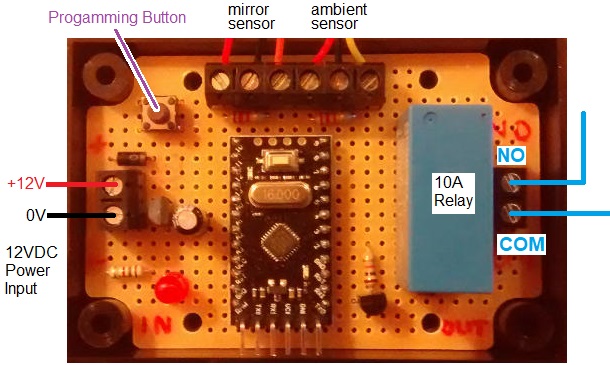A common problem for amateur astronomers is condensation forming on the mirror in their telescopes. During the night the mirror cools down, and then in the morning as the air warms up, condensation forms on the mirror which is colder than the surrounding air. The same thing happens to the surface of a bottle when you take it out of a fridge, but for a telescope it is problematic as condensation deteriorates the reflective coating on the mirror, and of course a foggy coating reduces the quality of the star images obtained by the telescope.
One solution to this problem is to warm up the mirror so that it remains 2 to 5 degrees Celcius above the ambient air temperature – something which can be achieved using a heating element and a thermostatic controller. If the mirror gets too cold, it will be covered in condensation. If the mirror gets too hot, it could warp. Therefore accurate control of the heating element is essential.
Pictured above is one such thermostatic controller we recently prepared for a customer loosely based around our 2013 Solar Water Heating Pump Controller.
This device has two ds18b20 digital temperature sensors – one which attaches behind the mirror of the telescope and the other which measures the ambient air temperature. When the temperature at the mirror falls to within 2°C (or any other user programmable value) warmer than ambient, the heating element is switched on (via the onboard relay). The heating element stays on until the mirror has heated up to be at least 5°C (or any other user programmable value) warmer than ambient.
We used a non-waterproof sensor at the back of the mirror as this area remains dry and that sensor needs to respond to quick temperature changes. (The protection on waterproof temperature sensors slows down their response to temperature change.) We did however use a waterproof sensor to measure ambient air temperatures because that sensor is exposed and ambient air temperatures change relatively slowly.
The heating cycle continues automatically ensuring condensation does not form on the mirror, and the mirror is not over heated. This is a 12VDC powered controller managing a 12VDC heating element so that it can be battery powered when used at remote locations.
If you need a user programmable thermostatic controller for your telescope heating element, please email neil@reuk.co.uk with details of your requirements.
